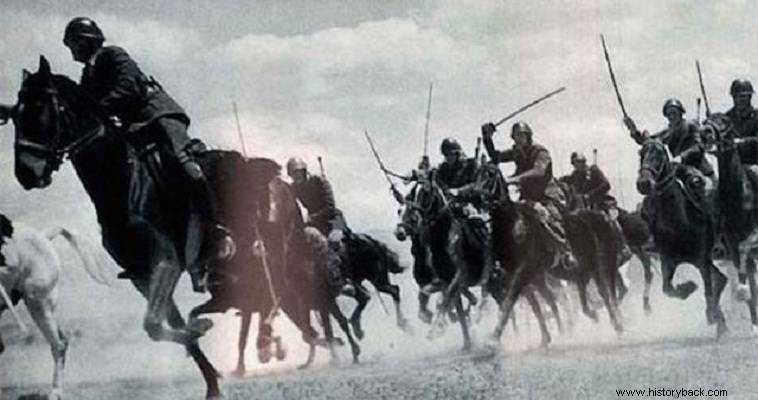
Cavalry was considered, not unjustly, an obsolete weapon during the Second World War. However, many of the belligerent countries developed cavalry formations and successfully so. When World War II broke out, the Italian Army raised six cavalry regiments, including the 3rd Dragoons in Savoy, which was the continuation of the homonymous regiment of the army of the kings of Piedmont.
Two by two, the Italian cavalry regiments joined the three fast-moving Celere divisions of the Italian Army. Each regiment had a nominal strength of 872 men, with 818 horse power, six motorcycles, 17 utility vehicles and 39 bicycles.
The Savoy Constitution
The Savoy Regiment was sent to the Eastern Front , joined the Russian Italian Expeditionary Force in the summer of 1941. The regiment organically belonged to the 3rd Cavalry Division d'Aosta. The regiment was well trained and its men had high morale.
Cavalry was an elite weapon in the Italian Army and the best officers were assigned to it, after a very tough selection. Each year, out of 900 officer candidates for the weapon, only 30 were selected.
The selection of non-commissioned officers and ordinary soldiers, even those classified in the gun, as well as the horses, was strict. The training time of a cavalry soldier was twice that of an infantryman, as the cavalryman had to be trained in both foot combat and horsemanship, while the horse was also trained.
The aim of the training was to develop the horse and the rider into a single unit. Then he followed education by ulama and then by ile. Apart from the high morale of the unit in general the relations of men and command were clearly better in the cavalry units than in the Italian infantry, due to the higher level, social and educational, of the officers of the weapon.
The commander of the Savoy Regiment in the USSR, for example, was Colonel Alessandro Bettoni, who was a two-time Olympic equestrian medalist and was well-liked and respected by his men.
The regiment was organized into two divisions, each with two regiments, and a machine-gun regiment. Each ile had three ulamas. The strength of the island reached 150 men. The men wore the distinctive grey-green battle dress worn by the other arms, but with black patches on the lapels of the shirt. Black was the distinctive color of the constitution, according to tradition.
Officers and soldiers wore the classic Italian M 1931 helmet, Mannlicher–Carcano, 6.5mm and straight swords, with a slight curve, as they were a dragoon regiment. On the helmet, in the front part, a black isosceles cross was painted, the emblem of the unit, that is.
Non-commissioned officers and soldiers carried telamo-style holsters, which were slung over the left shoulder, as standard holsters prevented riding. The officers carried pistols. The machine gun bay had 12 guns.
Combat NCOs carried submachine guns. On official occasions a gilt helmet was worn, with the cross of the House of Savoy on the front. The coat of arms of the Italian royal house, the white cross on a red background, was also the emblem of the regiment and was also carried as a small ensign, on the trumpets.
The officers wore tall, leather boots. Non-commissioned officers and soldiers wore short breeches with gaiters, over which they fitted leather gaiters. The insignia of the officers' rank was worn at the end of the sleeves and was the same as that of the other arms. The non-commissioned officers carried their "sardines" on the arm.
The last push
The regiment won eternal glory on August 24, 1942. At that time the regiment was deployed in the area south of the Don. His commander spotted a large force of Soviets and decided to attack.
An example of the men's high morale was that having spotted the Soviets from the night before, Bettoni ordered his men to form a defensive square in the middle of enemy-held territory, with the intention of attacking at first light.
At the same time wearing his white gloves and monocle he spoke to his men to raise their morale. He then dined with his officers, ordering campaign tables to be set with white tablecloths!
When dawn broke again the Italians calmly took their breakfast and prepared to attack. The regiment actually attacked the Soviet 812th Siberian Infantry Regiment near the village of Izbuzhensky.
Despite the fact that the Soviets almost quadrupled the Italians and had numerous machine guns and heavy weapons, they were overwhelmed by the combined Italian advance, with Bettoni unleashing the 2nd Illi first, against their left flank, while the 4th Illi had deployed to the front and fought with them on foot.
The advance of the 2nd Army surprised and shocked the Soviets. Then the rest of the islands also rushed into battle, and, on horseback, put the opponents to flight, causing them very heavy losses.
In total Soviet losses amounted to 150 dead, about 300 wounded and 600 prisoners. The Italian horsemen also captured four cannons, 50 machine guns and 10 mortars. The regiment had 32 dead and 52 wounded.
